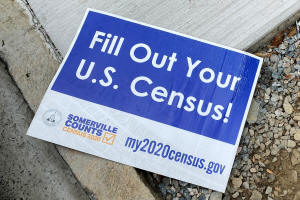U.S. census hands more House seats to Republican strongholds Texas,
Florida
 Send a link to a friend
Send a link to a friend
 [April 27, 2021]
By Joseph Ax [April 27, 2021]
By Joseph Ax
(Reuters) -Texas, Florida and North
Carolina are among the states that will gain congressional seats based
on new population data from the U.S. census, a shift that could boost
Republican chances of recapturing the U.S. House of Representatives from
Democrats in next year's midterm elections.
The overall U.S. population stood at 331,449,281, the Census Bureau said
on Monday, a 7.4% increase over 2010 representing the second-slowest
growth of any decade in history.
The release of the data, delayed for months due to the coronavirus
pandemic, sets the stage for a battle over redistricting that could
reshape political power in Washington during the next decade. States use
the numbers and other census data to redraw electoral maps based on
where people have moved.
Under the U.S. Constitution, the 435 seats in the House and the votes in
the Electoral College that select the president every four years are
divided among the 50 states based on population, with every state
receiving at least one congressional seat.

The seats are reallocated every 10 years following the decennial census
count.
The shift in seats reflects broader population trends that have seen the
South and West grow more rapidly than the Northeast and Midwest for
decades.
Texas will receive two more congressional seats next year, and five
states - Florida, North Carolina, Colorado, Montana and Oregon - will
gain one congressional seat each, the census bureau said.
New York, California, Illinois, Michigan, Ohio, Pennsylvania and West
Virginia will each lose one seat. California, the most populous U.S.
state, lost a congressional seat for the first time in its 170-year
history.
The reapportionment can come down to razor-thin margins. If New York had
89 more people in the census count, for instance, it would have kept its
seat at the expense of Minnesota, officials said.
The gains for states such as Texas, North Carolina and Florida, where
Republicans control the legislatures, could be enough to erase
Democrats' current narrow majority in the House. Republicans in those
three states have in the past engaged in aggressive gerrymandering, the
practice by which maps are deliberately redrawn to benefit one party
over another.
"I'd expect, just from reapportionment, the Republicans to win a few
seats," said Kyle Kondik, an election analyst at the University of
Virginia. Republicans only need to flip five seats in 2022 to retake the
House.
Every state uses the census data to redraw lines both for districts and
thousands of state legislative seats in a process known as
redistricting.
[to top of second column]
|

A sign encouraging participation in the U.S. Census lies on a
sidewalk in Somerville, Massachusetts, U.S., August 4, 2020.
REUTERS/Brian Snyder/File Photo

That work cannot be completed until the census
releases more precise block-by-block data, which is slated for
September. The delay has raised concerns that states will be forced
to rush through the complicated process of redistricting ahead of
the next elections.
The U.S. Supreme Court ruled in 2019 that federal courts have no
power to restrict political gerrymandering, although racial
gerrymandering - which aims to curb the political power of specific
racial or ethnic groups - remains unlawful.
The four most populous U.S. states - Texas, Florida and New York,
along with California - have more than 110 million residents
combined and will hold about one-third of the House seats.
The shift of seven seats among 13 states was the smallest number of
seats moving among states in any decade since the current method of
calculating them was adopted in 1941, officials said.
SLOW GROWTH
Overall, the U.S. population grew more slowly from 2010 to 2020 than
in every other decade aside from the 1930s, during the Great
Depression, census officials said.
Population growth has slowed as the birth rate has declined, while
the "baby boomer" post-World War Two generation has aged. In
addition, immigration sharply decreased due to the hardline policies
of the Trump administration.
Utah's population grew faster than any other state's, increasing by
more than 18% since 2010. Only three states lost population: West
Virginia, which saw its population decrease by 3.2%, followed by
Illinois and Mississippi, which dropped by 0.1% and 0.2%,
respectively.
Washington, D.C., the nation's capital, grew by 14.6% to a
population of 689,545. House Democrats have passed legislation to
admit the district as the 51st state, but Republicans oppose the
measure.
The territory of Puerto Rico, which was devastated by Hurricane
Maria in 2017, has seen its population decrease by 11.8% since 2010.
Wyoming remains the least populated state, with 576,851 residents.
(Reporting by Joseph AxAdditional reporting by Jason Lange and Doina
ChiacuEditing by Colleen Jenkins, Bill Berkrot and Sonya Hepinstall)
[© 2021 Thomson Reuters. All rights
reserved.] Copyright 2021 Reuters. All rights reserved. This material may not be published,
broadcast, rewritten or redistributed.
Thompson Reuters is solely responsible for this content. |